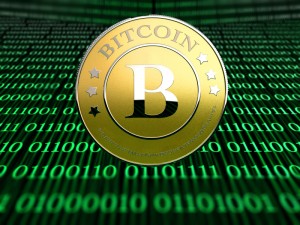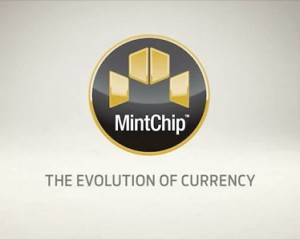From Bitcoin to MintChip?

The present.
I first wrote about Bitcoin almost a year ago. At the time, they were selling for $105 each. I didn’t buy any because they had just surged in value and it seemed like a bubble that would surely burst. Today, they’re selling for $664. So much for my ability to forecast the world’s first virtual currency.
There’s a lot that I like about Bitcoins. Their value is based on supply and demand, not government fiat. They’re anonymous like cash but they’re easier to manage and harder to lose. I thought maybe they were theft-proof but I was wrong about that.
On the other hand, there are a lot of things not to like about Bitcoin. Like the fact that so much of the infrastructure is run by shady characters and incompetent (or malevolent) twenty somethings. One of the leading Bitcoin users went by the name Dread Pirate Roberts before he got busted. Bitcoin exchanges – including the largest, Mt. Gox — have been plundered, apparently through sheer incompetence. Just the other day, the Financial Times reported on the first “unnatural death” associated with the Bitcoin universe.
Yet, the price holds steady and shows no signs of returning to where it was a year ago. To be fair, the price skyrocketed to $1,151 in December and has fallen back since – so it was a bit of a bubble. But I would still be happy if I had bought a few Bitcoins at the time I wrote my first article.
And now – apparently – the originator of Bitcoin has been identified. The original Bitcoin manifesto and block of code was published by someone using the name Satoshi Nakamoto. The world assumed that this was a pseudonym and spent many sleepless hours trying to figure out who the “real” author was. Who could write such compact, elegant, and brilliant code? Now Newsweek claims to have found the author. His name is Satoshi Nakamoto, a toy train enthusiast who lives near Los Angeles. (Late breaking news — maybe he’s not the real guy after all).
So, what’s next? Bitcoin has whetted our appetites for a currency that’s not controlled by governments or banks. We seem to like a currency that’s transparent and based on the laws of supply and demand rather than politics. Now if we could just get rid of the crooks and fools.
So where to turn? Perhaps Canada. In 2012, the Royal Canadian Mint announced the MintChip project – a digital

The future?
currency that’s not quite the same as Bitcoin but similar. MintChip got a lot of press when the Canadian government launched the MintChip challenge to create an ecosystem of MintChip apps. The publicity died out quickly but as recently as September 2013, Marc Brûlé, the head of the project, said MintChip is still moving forward and hinted at a MintChip 2.0.
For me, the big differences between Bitcoin and MintChip are that MintChip is run by grownups and backed by a credible government. It has many of the advantages of Bitcoin but few of the disadvantages. After all, we all trust Canada don’t we?
Worried About the Euro? Try Bitcoin.

Got any bitcoins?
With the serial crises in the Euro zone, one has to wonder if the currency will survive. If it doesn’t, one assumes that individual countries will return to their national currencies: the drachma, lira, peseta, etc. But do they have to? Who says that a currency has to be sponsored by a national government?
That’s part of the theory behind Bitcoin, the most successful virtual currency in history. Bitcoins exist as highly encrypted computer transactions. The currency was created in 2009 by an extremely talented programmer (or programmers) using the pseudonym Satoshi Nakamoto. Roughly 31,000 lines of very tightly written code generate 2½ bitcoins per minute. (The rate will vary over time until 21 million bitcoins are produced). Bitcoin enthusiasts use high-powered servers to “mine” the bitcoins; they usually sell them on exchanges like Mt. Gox. The system uses the same servers to track transactions and ensure that no one person can spend the same bitcoin twice.
The bitcoin system uses peer-to-peer networking, meaning that there’s no central office or person or committee responsible for managing operations. That also means there’s no one to arrest if national authorities decide that the operation is illegal (which, so far, they haven’t). As Nakamoto pointed out in an early manifesto, today’s fiat currencies require us to trust national governments and central banks, which seem to regularly abuse that trust. The bitcoin, on the other hand, is based on “crypto proof instead of trust.” If you trust cryptography more than you trust central banks, the bitcoin is for you.
Bitcoins have all the advantages of cash, including anonymity. They also remove most of the disadvantages of cash: you can’t lose them, they (apparently) can’t be stolen, and they’re not bulky and hard to transfer. Because there’s no middle man, transaction costs are also very low. Anonymity and ease-of-use appeal to three significant demographics: libertarians, criminals, and those who predict the collapse of national currencies.
The never-ending euro crisis has driven bitcoins to new heights of popularity. There are now roughly 10.5 million bitcoins in circulation. Like a commodity, their price is governed by supply-and-demand. Since the Cyprus crisis erupted, their value has nearly tripled and they recently sold for about $105 each — meaning that the total value of bitcoins in circulation is now over $1 billion.
Their popularity has expanded in other ways as well. Search for “bitcoin” on Amazon and you’ll find 54 different publications. There’s also a magazine, which has a good overview article (complete with common misconceptions). Canada is even experimenting with a virtual currency called the MintChip which may have many of the features of Bitcoin but with the backing of a national government. The hype is accelerating and, as Andrew Leonard points out in Salon, that may be the beginning the end. Because of its growing popularity, the Feds are now starting to pay attention.
The best introduction to bitcoins is probably Joshua Davis’ article in The New Yorker in October 2011. Davis provides a very good layman’s summary of bitcoin operations and also attempts to track down Satoshi Nakamoto. In an article in Fast Company, Adam Penenberg, also tries to identify Nakamoto and comes up with a trio of possibilities — not the same suspects that Davis identifies.
It’s fun to speculate where all this might lead. So far, I haven’t bought any bitcoins. The value has gone up so much in recent months that it seems like a bubble. I am curious, however, if any of my readers have bought and spent bitcoins. If so, be sure to let us know about your experiences.